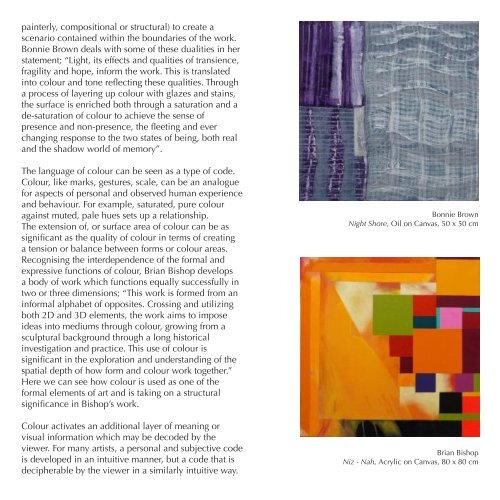trim- PDFV14pdf
You also want an ePaper? Increase the reach of your titles
YUMPU automatically turns print PDFs into web optimized ePapers that Google loves.
painterly, compositional or structural) to create a<br />
scenario contained within the boundaries of the work.<br />
Bonnie Brown deals with some of these dualities in her<br />
statement; “Light, its effects and qualities of transience,<br />
fragility and hope, inform the work. This is translated<br />
into colour and tone reflecting these qualities. Through<br />
a process of layering up colour with glazes and stains,<br />
the surface is enriched both through a saturation and a<br />
de-saturation of colour to achieve the sense of<br />
presence and non-presence, the fleeting and ever<br />
changing response to the two states of being, both real<br />
and the shadow world of memory”.<br />
The language of colour can be seen as a type of code.<br />
Colour, like marks, gestures, scale, can be an analogue<br />
for aspects of personal and observed human experience<br />
and behaviour. For example, saturated, pure colour<br />
against muted, pale hues sets up a relationship.<br />
The extension of, or surface area of colour can be as<br />
significant as the quality of colour in terms of creating<br />
a tension or balance between forms or colour areas.<br />
Recognising the interdependence of the formal and<br />
expressive functions of colour, Brian Bishop develops<br />
a body of work which functions equally successfully in<br />
two or three dimensions; “This work is formed from an<br />
informal alphabet of opposites. Crossing and utilizing<br />
both 2D and 3D elements, the work aims to impose<br />
ideas into mediums through colour, growing from a<br />
sculptural background through a long historical<br />
investigation and practice. This use of colour is<br />
significant in the exploration and understanding of the<br />
spatial depth of how form and colour work together.”<br />
Here we can see how colour is used as one of the<br />
formal elements of art and is taking on a structural<br />
significance in Bishop’s work.<br />
Colour activates an additional layer of meaning or<br />
visual information which may be decoded by the<br />
viewer. For many artists, a personal and subjective code<br />
is developed in an intuitive manner, but a code that is<br />
decipherable by the viewer in a similarly intuitive way.<br />
Bonnie Brown<br />
Night Shore, Oil on Canvas, 50 x 50 cm<br />
Brian Bishop<br />
Niz - Nah, Acrylic on Canvas, 80 x 80 cm


